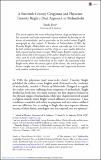A sixteenth-century clergyman and physician : Timothy Bright's dual approach to melancholia
Abstract
This article explores the nexus of healing between clergy and physicians in late sixteenth- and early seventeenth-century medicine by focusing on the disease of melancholia, and in particular on the earliest extant English monograph on that subject, A Treatise of Melancholie (1586), by Timothy Bright. Melancholia was a disease especially apt to be treated by both medical practitioners and the clergy as it was widely defined as both corporal and spiritual in origin. What makes Bright's treatise particularly noteworthy is the vocation of the author: Bright was both doctor and cleric, and his work straddled both occupations as he defined, diagnosed and attempted to cure melancholy in his reader. By examining what Bright wrote about the various aspects of the disease, this article provides further insight into the clashes, conciliations and cooperation between early modern medical practitioners.
Citation
Betz , E 2022 , ' A sixteenth-century clergyman and physician : Timothy Bright's dual approach to melancholia ' , Studies in Church History , vol. 58 , pp. 112-133 . https://doi.org/10.1017/stc.2022.6
Publication
Studies in Church History
Status
Peer reviewed
ISSN
0424-2084Type
Journal article
Collections
Items in the St Andrews Research Repository are protected by copyright, with all rights reserved, unless otherwise indicated.

